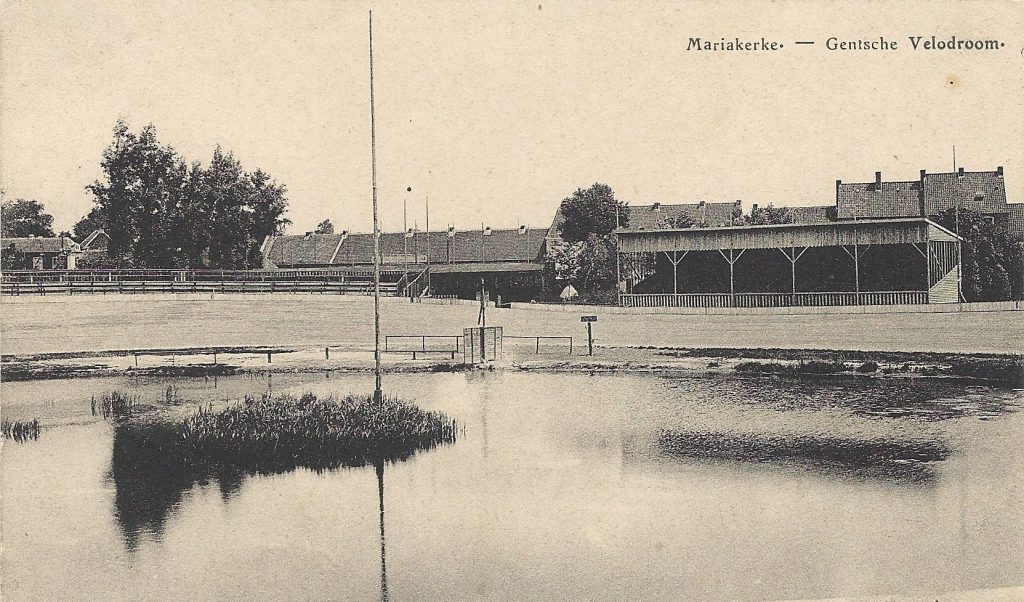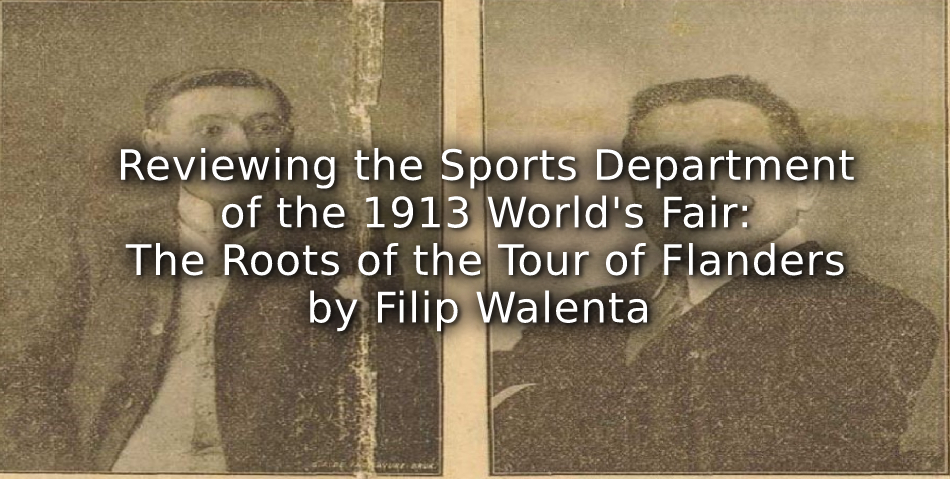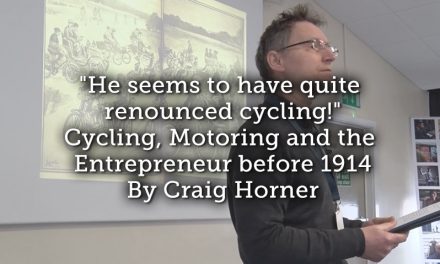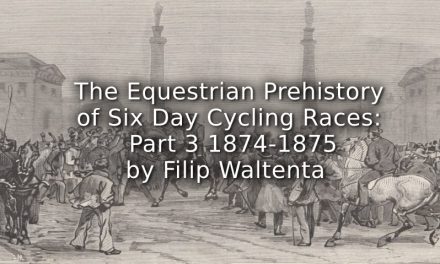In the annals of cycling history we read that the first Tour of Flanders in 1913 was organized by the leading sports magazine Sportwereld as a publicity stunt to the example of the French l‘Auto (Tour de France) and the Italian La Gazetta dello Sport (Giro d’Italia).
According to the myth the idea came from the first Belgian overall winner of the 1912 Tour de France Odiel Defraeye. He told the sports journalist Karel Van Wijnendaele before the start of a cycling race “… that it would be nice to have a cycling race in Flanders just like in France”. Inspired by this conversation later in the day Karel drew down the track of the race he had in mind on a bear mat in the local pub.
A nice story that perfectly fits in the romanticized myth-making, but the Tour of Flanders of 1913 was not the very first as commonly accepted, and also the immediate cause for the organization of the race probably came from a totally different corner.

The Tour of Flanders in 1913 finished in the velodrome of Mariakerke. (Picture postcard)
The first Tours of Flanders
From 1908 till 1912 several Tours of Flanders were organized by different clubs, velodrome managements and sports federations. As trade names were not commonly established in that period, depending on the newspaper or the reporter sometimes the race was called similar names like Circuit of Flanders or Route of Flandres. As consequence the first Tour of Flanders was not founded by Karel Van Wijnendaele and Sportwereld, and also the trade name was not their idea.[1]
The multi-disciplinary sports union Union Belge des Sociétés de Sports Athlétiques (UBSSA) held the race in cooperation with the sports journal Het Sportblad from 1908 till 1910. It was a two day cycling event for several categories of amateurs, tourists and juniors.[2] However, the very first time the name Tour of Flanders was used for a cycling race was in Moorslede, the hometown of ‘Lion of Flanders’ Cyriel Vanhouwaert. On 24 May 1908 a cycling event was organized by the management of the local velodrome with several contests among which a road race that finished on the track, called the Tour of Flanders.[3]
‘Belgian Pride, Flemish Lion, Local Hero: Cyriel van Hauwaert and Identity Construction in Cycling’ by Stein Knuts at the 2018 MMU Playing Pasts Forum.
The 1913 World’s Fair in Ghent
Already in 1905 the mayor Emile Braun and the city council were convinced that Ghent -in the footsteps of Antwerp (1894), Brussels (1897 and 1910) and Liège (1905)- had to apply for the organization of the 1909 World’s Fair.[4] Finally it would take four more years before Ghent was qualified to organize this enormous event.
The World’s Fair of 1913 was the city’s most prestigious project ever. It was inaugurated on Saturday the 26 April and closed on Monday 3 November 1913. Dozens of majestic pavilions, parks, ponds and fountains were spread over a terrain of hundred and thirty acres in the Southern outskirts of the city. As capitol of Flanders, Ghent would represent the whole industry of the region and all the Belgian cities.[5] The sports department and the department of bicycles, motor vehicles and aviation were assured of a lot of attention in the Industry and Sciences Pavilion.
In order to manage and coordinate all the planned events that took place in the framework of the Expo a special sports committee was founded. It was chaired by the well known sports man and industrialist Albert-Eugene Feyerick, president of the International Fencing Federation FIE (Fédération Internationale d’Escrime) from 1913 until his death in 1919 and founder of the Royal Latem Golf Club in 1909.[6] Visitors of the World’s Fair could regularly witness races and matches of athletics, gymnastics, boxing, lawn tennis, cycling, fencing, golf, aerial sports, etc as well as in the sporting fields and pitches of the Modern Village as outside the Expo’s terrains. The most significant events were the world championships lawn tennis and wrestling, and the European championships rowing in the harbor and boxing for heavy weights between the East Londoner ‘Bombardier’ Billy Wells against the Frenchman George Carpentier.[7]
On Saturday afternoon the 31st of May the pavilions of the Belgian industries -including the bicycle, motor and car industries- were officially opened.[8] Several bicycle brands had build promotion stands to present their newest models and innovations.[9] And in the sports salon all the sporting federations were represented, the Belgian cycling union (BWB) included.
Several cycling competitions for clubs and amateurs were organized among which three races for independent professional riders: the Great Opening Price of the World’s Fair on April 13, the Great Price of Ghent on May 18 and the Flanders Championship on June 15.[10][11]
Mostly the finish line was situated inside the Expo’s domain where some athletic and cycling races were held in expectation of the arrival of the first riders.[12]

The main entrance of the World’s Fair with on the left the pavilion of the Belgian sports salon. (Picture postcard)
The Tour of Flanders … second choice?
An international cycling event was also planned by the sports department of the Expo. Therefore committee member Emile De Beukelaer, president of the sports committee of the Belgian cycling union (BWB) and first UCI president, was contacted. His lobbying efforts at the UCI Congress in Paris in February 1913 were supposed to bring the world championships track cycling to Ghent.[13] Unfortunately they were assigned to Berlin and Leipzig, consequently the committee had to search for a worthy alternative.[14]
Did the management of Sportwereld take advantage of this situation by organizing the Tour of Flanders on its own initiative? Or was Sportwereld contacted by the sports committee and proposed to organize a professional cycling race? Several arguments prove that there were far-reaching contacts between the sporting committee and the cycling world.
Firstly, nearly all functions of the cycling department of the committee were occupied by top members of the Belgian cycling union.[15] Thanks to their negotiations the three velodromes surrounding Ghent (Evergem, Gentbrugge and Mariakerke) had agreed to increase their amount of cycling events, in such a way that nearly every weekend a race took place. Secondly, the sports committee of the Expo knew that there was a lot of organizing talent present within Sportwereld. Karel Van Wijnendaele was manager of the Torhout velodrome and a member of the velodrome committee of the BWB, while Leon Van Den Haute had been involved for years in the organizing committees of Paris-Roubaix, Paris-Brussels and the Tour of Belgium.[16] And Sportwereld was not afraid to use its influence and its journalistic authority because it was the only available sports newspaper that was sold within the walls of the Expo.[17]
And thirdly, the fact that the article about the assignation of the world championships track cycling to Berlin and Leipzig appeared in the press on 10 February 1913, the same day of the first announcement of the Tour of Flanders in Sportwereld, can hardly be considered as coincidental.[18]

Karel Van Wijnendaele and Leon Van Den Haute in the very first Sportwereld of 13 September 1912
The fact that the starting point was situated along the other side of town can be considered as a counterargument. Jos Billen, an amateur historian and founder of the Gent1913.eu project, argues that a cycling event preferably had to start and finish within the walls of the World’s Fair.[19] But it is also possible that the infrastructure and staff of the Expo could not provide the necessary logistic and administrative facilities like sleeping accommodation for the riders, guarded parking for the follow cars and secured storage for the sealed bicycles. And the rowing events were held in the canals of the Ghent harbor on the other side of town.
Up till now hard evidence has not been found, the only clue we can find back is an article by the journalist Diederik Die Vos in which he wrote:
“… and the Tour of Flanders organized by Sportwereld is held on the occasion of the World’s Fair”.[20]
A vague answer and more questions
Whether and to what extent the Tour of Flanders was organized in cooperation with or on behalf of the sports committee of the World’s Fair is still not clear, but the hypothesis cannot be ignored. Sportwereld wanted, just like the other sports newspapers, profile itself as a reliable organizer of sports competitions while taking advantage of the immense attention the city of Ghent enjoyed as cultural capital of the country.
The World’s Fair was beyond any doubt the reason why the 1913 Tour of Flanders started and finished in Ghent. But it also gives raise to the question if the Tour of Flanders was meant to be a one-day-event, and if in consequence of the immense success only then Sportwereld decided to organize a following edition.
Article 2021 @ Filip Walenta
Karelvanwijnendaele.be Projec
References
[1] Gazette van Brugge, 6 June 1908; Gazette van Brugge, 21 May 1913.
[2] Gazette van Brugge, 22 May 1909; Het Laatste Nieuws, 16 May 1909.
[3] De Poperinghenaar, 17 May 1908.
[4] ‘De aanloop’, Ghent 1913. The World Fair.
<https://gent1913.eu/de-aanloop-2/> (Accessed: February 12, 2021)
[5] ‘De expo’, Ghent 1913. The World Fair.
<https://gent1913.eu/de-expo/26-april-1913/> (Accessed: February 12, 2021)
[6] ‘Jacques Feyerick’, Wikipedia. The Free Encyclopedia.
<https://en.wikipedia.org/wiki/Jacques_Feyerick> (Accessed: February 12, 2021)
[7] Vaderland, 3 April 1913; Vooruit, 18 May 1913.
[8] Het Volk, 1 June 1913.
[9] ‘Sport salon’, Ghent 1913. The World Fair.
< https://gent1913.eu/sport-salon/> (Accessed: February 12, 2021)
[10] Sportwereld, 30 April 1913.
[11] The ‘independents’ was a former category of cyclists founded in 1911 by the Belgian cycling union. Amateurs had to win a few races in this category before becoming professional in a bicycle brand supported team.
[12] Sportwereld, 11 April 1913.
[13] Gazet van Antwerpen, 29 November 1912.
[14] Het Handelsblad, 10 February 1913.
[15] Sportwereld, 30 April 1913.
[16] Sportwereld, 12 September 1912.
[17] Sportwereld, 13 June 1913.
[18] Het Handelsblad, 10 February 1913; Le Journal Amusant, 15 February 1913; Sportwereld, 10 February 1913.
[19] Ghent 1913. The World Fair.
< https://gent1913.eu/> (Accessed: February 12, 2021)
[20] Sportwereld, 30 April 1913.





